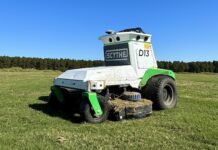Eight years ago, I was approached to write a report about sustainability for the green industry. While the small stipend offered for my services figured into my acceptance, the bigger reason that I said “yes” to the assignment was my naive conviction that I was knowledgeable about the subject of sustainability already. I gave myself too much credit.
The project turned out to be more challenging than I had anticipated.
In fact, I came out of the experience convinced that there is no definitive, “fully agreed upon” guide to sustainability in the green industry. Yes, there are many things most of us can agree upon — water conservation, soil preservation/health, etc. But I also learned that what one knowledgeable person sees as a sustainable product or practice, another equally knowledgeable person may view as unsustainable. The two well-meaning, intelligent individuals may agree on sustainability’s mantras — the 3 P’s (Planet, People, Profits), the 3 R’s (Reduce, Reuse, Recycle), etc. — but they may still disagree on issues, pesticide use being one of the most polarizing.
In preparing the sustainability report I served as the scribe for more than 20 respected green industry experts. They spent two intense days discussing (and in some cases, debating) a wide-range of subjects related to sustainability. I filled three notebooks with their opinions. My scribblings served as the source material for my report.
That particular experience came to my mind recently when I read an article entitled “Without Glyphosate, What Would Farming Look Like?” The article appeared in the Genetic Literacy Project, an e-newsletter that I regularly receive and enjoy reading. Genetically modified organisms are making a huge impact in agriculture, and I’m convinced transgenic solutions will some day loom large in the green industry, too. But I’ll leave that subject for another day.
The author, Dave Walton, is an Iowa farmer growing corn, soybeans, alfalfa and hay. Walton’s piece attracted my attention mainly because the headline promised a real-world view of glyphosate use by a progressive farmer on a working farm.
All of us are familiar with glyphosate and most of us use it. We landscape professionals, along with millions of homeowners, depend upon this popular, systemic, broad-spectrum herbicide for many different reasons — from killing grass growing in the crevices of our sidewalks and driveways to clearing properties for renovation to destroying unwanted invasive plants in our parks and other public areas.
Any of us can go to our local Ace Hardware, big box or garden supply store and buy products containing glyphosate. Although many people still refer to any product containing the chemical as Roundup (the name Monsanto gave it on its release in 1974), many companies now sell products containing glyphosate, which became post-patent in 2000. It’s one of the most popular herbicides in the world, being used in more than 160 countries, according to Monsanto.
Why are glyphosate-based products so popular and their use so ubiquitous? Two big reasons.
Number one: They work. They kill a wide variety of plants, including annual and perennial grasses, broadleaf weeds, trees and shrubs. Actively growing plants translocate glyphosate throughout the plant where the chemical inhibits enzymes involved in the synthesis of live-sustaining amino acids. These products act fast, too. Symptoms of treated plants begin to appear within days for annual weeds and within a week or two for tougher perennials.
Number two: Products containing glyphosate are widely considered to be safe. Extensive testing (more than 800 studies) has shown that these products have very low acute toxicity to people and wildlife, and that they’re unlikely to pose a carcinogenic risk to humans.
Even so, glyphosate has its critics. Many critics.
Efforts to restrict or ban the use of the chemical pop up regularly – and especially so since the worldwide adoption of GMO (Roundup-resistant) crops these past 20 years. A report published in 2015 by the International Agency for Research on Cancer , an arm of the World Health Organization, listed glyphosate as a “probable carcinogen.” The report fueled fresh efforts by anti-GMO activists restrict its use.
Monsanto denied the claim and requested a retraction of the IARC report. The company consistently points to the scores of studies carried out over the past 40 years that have found no connection between glyphosate and cancer.
In spite of Monsanto’s defense of the chemical and agriculture’s dependence upon it, organic farming proponents and anti-GMO activists regularly decry the “dousing” of “drowning” of cropland with dangerous chemicals.
Is this, along with the discovery of glyphosate-resistant weeds, enough to tar the active ingredient’s use as “unsustainable?”
Walton, director, Iowa Soybean Association, argues the opposite; the use of glyphosate is a much-needed management tool for “sustainable” agriculture. In his article, Walton points out the terms “dousing” and “drowning” are very misleading.
“On our farm, we grow both BMO and non-GMO crops. When planting season arrives in Iowa, I begin applying herbicides to prepare for planting. On our no-till ground — the most sustainable form of agriculture, and it’s been made possible by the use of GM crops — we use a combination of glyphosate, 2,4-D and metalachor for corn,” writes Walton.
As for “drowning” his cornfields in pesticides, Walton points out that, before planting, he applies 16 ounces of glyphosate along with a small amount of the other chemicals – little more than a half a gallon of total herbicide spread over an acre or approximately 1/3 of a drop per square foot.
“We’re not ‘drowning’ plants in pesticides; we’re using what amounts to an eyedropper,” writes Walton.
Indeed, the combination of glyphosate-resistant crops and the greater understanding and adoption of the no-till farming (reducing the erosion, weed and soil-structure problems associated with row-crop tillage) has resulted in what Walton opines as a “great ecological package.”
This Iowa farmer’s point of view toward the use of a popular chemical, based upon his real-world experience, is at odds with individuals and organizations that see the issue in a totally different light. How you weigh the value of their arguments ultimately colors your perception of sustainability in agriculture.
The same holds true in the green industry, I discovered in the exercise of writing the sustainability report almost a decade ago.
Is there a “true and unvarnished” version of sustainability that all of us can agree upon? I’m sure there’s not, but it’s a goal we build upon by not relying so much on what we thought we knew and by opening our minds to demonstrable evidence and observable outcomes instead.
Read more: From Corn Tassels to Transgenic Lawn Grasses











![[VIDEO] Dickies®: Discover Workwear That’s Anything But Uniform](https://turfmagazine.com/wp-content/uploads/2023/06/1647663814-4b1a2a7742790a9b1e97a3b963477850192e1d6a9dfba9b07214a77bae25d6e3-d-218x150.jpg)



























![[VIDEO] Dickies®: Discover Workwear That’s Anything But Uniform](https://turfmagazine.com/wp-content/uploads/2023/06/1647663814-4b1a2a7742790a9b1e97a3b963477850192e1d6a9dfba9b07214a77bae25d6e3-d-324x160.jpg)
It’s almost a fair and balanced take on this controversial chemical, but is of course colored by the fact that your magazine often serves as an advertorial for landscape chemical interests. As you note, many would agree that their IS controversy – and that we can read carefully considered opposing viewpoints online. What I would like to see from Turf is a real and open dialogue within the pages of “my” industry magazine. That may be too much to ask for a publication that relies too heavily on RISE members for revenue. To become a ‘true’ voice of the industry, rank-and-file landscape industry folks deserve better and more balanced editorials. For now, readers need to make up their own minds and must look elsewhere – because Turf and most of the “industry” magazines won’t publish from the viewpoint that landscape chemical use deserves a fair and balanced debate.
This article is not about sustainability but a pro-glyphosate advertorial. Of course, there are programs that agree on sustainability! Finding 1 farmer in Iowa that combines 3 chemicals to kill his weeds is certainly not someone I would turn to for sound advice on sustainability. I am a Certified Sustainable Landscape Professional in Washington State (or ecoPRO as they call it with a certification EPC). Sustainability looks at the three primary categories (Design, Construction and Maintenance) and focuses on eight guiding principles: 1) Protect and Conserve Soils, 2) Conserve Water, 3) Protect Water and Air Quality, 4) Protect and Create Wildlife Habitat, 5) Conserve Energy, 7) Sustain Healthy Plants, 8) Use Sustainable Methods and Materials Protect and Enhance Human Health and Well‐being. These are teachable practices. The program is administered jointly by the WA Assoc of Landscape Professionals, the WA State Nursery and Landscape Assoc, and the WA Dept of Ecology. The program can be found at: http://www.ecoprocertified.org. Ron Hall, I met you many, many years ago at a conference and at that time I offered to talk with you about organics and sustainability. I never heard from you. My offer still stands anytime you want to know how we do things without needing to use glyphosate, 2,4-D or metalachor.